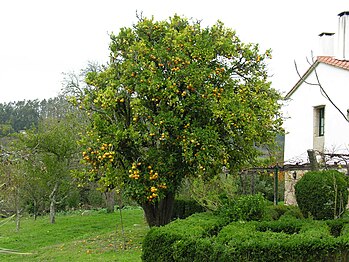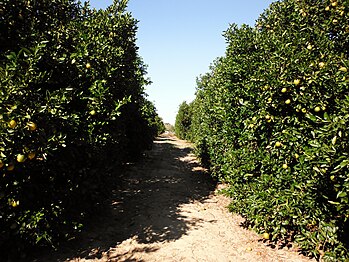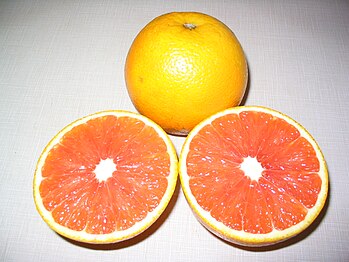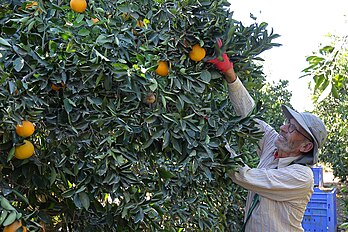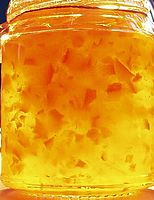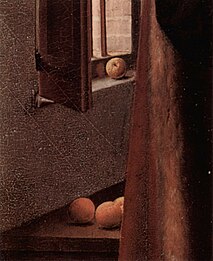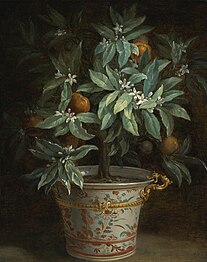Orange (fruit)

An orange, also called sweet orange to distinguish it from the bitter orange Citrus × aurantium, is the fruit of a tree in the family Rutaceae. Botanically, this is the hybrid Citrus × sinensis, between the pomelo (Citrus maxima) and the mandarin orange (Citrus reticulata). The chloroplast genome, and therefore the maternal line, is that of pomelo. The sweet orange has had its full genome sequenced.
The orange originated in a region encompassing
Oranges have featured in human culture since ancient times. They first appear in Western art in the Arnolfini Portrait by Jan van Eyck, but they had been depicted in Chinese art centuries earlier, as in Zhao Lingrang's Song dynasty fan painting Yellow Oranges and Green Tangerines. By the 17th century, an orangery had become an item of prestige in Europe, as seen at the Versailles Orangerie. More recently, artists such as Vincent van Gogh, John Sloan, and Henri Matisse included oranges in their paintings.
Description
The orange tree is a relatively small
-
Flowers
-
Fruit starting to develop
-
Flowers and fruit simultaneously
-
Mature tree inGalicia, Spain, fruiting in November
-
Structure of the botanical hesperidium
History
Hybrid origins
The sweet orange, The fruit was created as a cross between a non-pure mandarin orange and a hybrid pomelo that had a substantial mandarin component.[13][14] Since its chloroplast DNA is that of pomelo, it was likely the hybrid pomelo, perhaps a pomelo BC1 backcross, that was the maternal parent of the first orange.[15][16] Based on genomic analysis, the relative proportions of the ancestral species in the sweet orange are approximately 42% pomelo and 58% mandarin.[17] All varieties of the sweet orange descend from this prototype cross, differing only by mutations selected for during agricultural propagation.[16] Sweet oranges have a distinct origin from the bitter orange, which arose independently, perhaps in the wild, from a cross between pure mandarin and pomelo parents.[16]
Sweet oranges have in turn given rise to many further hybrids including the grapefruit, which arose from a sweet orange x pomelo backcross. Spontaneous and engineered backcrosses between the sweet orange and mandarin oranges or tangerines have produced the clementine and murcott. The ambersweet is a complex sweet orange x (Orlando tangelo x clementine) hybrid.[17][18] The citranges are a group of sweet orange x trifoliate orange (Citrus trifoliata) hybrids.[19]

Arab Agricultural Revolution
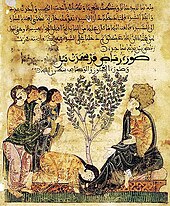
In Europe, the Moors introduced citrus fruits including the bitter orange, lemon, and lime to Al-Andalus in the Iberian Peninsula during the Arab Agricultural Revolution.[20] Large-scale cultivation started in the 10th century, as evidenced by complex irrigation techniques specifically adapted to support orange orchards.[21][20] Citrus fruits—among them the bitter orange—were introduced to Sicily in the 9th century during the period of the Emirate of Sicily, but the sweet orange was unknown there until the late 15th century or the beginnings of the 16th century, when Italian and Portuguese merchants brought orange trees into the Mediterranean area.[11]
Spread across Europe
Shortly afterward, the sweet orange quickly was adopted as an edible fruit. It was considered a luxury food grown by wealthy people in private conservatories, called
To the Americas
Spanish travelers introduced the sweet orange to the American continent. On his second voyage in 1493, Christopher Columbus may have planted the fruit on Hispaniola.[6] Subsequent expeditions in the mid-1500s brought sweet oranges to South America and Mexico, and to Florida in 1565, when Pedro Menéndez de Avilés founded St Augustine. Spanish missionaries brought orange trees to Arizona between 1707 and 1710, while the Franciscans did the same in San Diego, California, in 1769.[11] Archibald Menzies, the botanist on the Vancouver Expedition, collected orange seeds in South Africa, raised the seedlings onboard, and gave them to several Hawaiian chiefs in 1792. The sweet orange came to be grown across the Hawaiian Islands, but its cultivation stopped after the arrival of the Mediterranean fruit fly in the early 1900s.[11][24] Florida farmers obtained seeds from New Orleans around 1872, after which orange groves were established by grafting the sweet orange on to sour orange rootstocks.[11]
Etymology
The word "orange" derives ultimately from
The word entered
Composition
Nutrition
| Nutritional value per 100 g (3.5 oz) | |
|---|---|
| Energy | 197 kJ (47 kcal) |
11.75 g | |
| Sugars | 9.35 g |
| Dietary fiber | 2.4 g |
0.12 g | |
0.94 g | |
Niacin (B3) | 2% 0.282 mg |
| Pantothenic acid (B5) | 5% 0.25 mg |
| Vitamin B6 | 4% 0.06 mg |
| Folate (B9) | 8% 30 μg |
| Choline | 2% 8.4 mg |
| Vitamin C | 59% 53.2 mg |
| Vitamin E | 1% 0.18 mg |
| Minerals | Quantity %DV† |
| Calcium | 3% 40 mg |
| Iron | 1% 0.1 mg |
| Magnesium | 2% 10 mg |
| Manganese | 1% 0.025 mg |
| Phosphorus | 1% 14 mg |
| Potassium | 6% 181 mg |
| Zinc | 1% 0.07 mg |
| Other constituents | Quantity |
| Water | 86.75 g |
| †Percentages estimated using US recommendations for adults,[31] except for potassium, which is estimated based on expert recommendation from the National Academies.[32] | |
Orange flesh is 87% water, 12%
Phytochemicals
Oranges contain diverse
Taste
The taste of oranges is determined mainly by the ratio of sugars to acids, whereas orange aroma derives from volatile organic compounds, including alcohols, aldehydes, ketones, terpenes, and esters.[36][37] Bitter limonoid compounds, such as limonin, decrease gradually during development, whereas volatile aroma compounds tend to peak in mid– to late–season development.[38] Taste quality tends to improve later in harvests when there is a higher sugar/acid ratio with less bitterness.[38] As a citrus fruit, the orange is acidic, with pH levels ranging from 2.9[39] to 4.0.[39][40] Taste and aroma vary according to genetic background, environmental conditions during development, ripeness at harvest, postharvest conditions, and storage duration.[36][37]

Cultivars
Common
Common oranges (also called "white", "round", or "blond" oranges) constitute about two-thirds of all orange production. The majority of this crop is used for juice.[4][6]
Valencia
The Valencia orange is a late-season fruit; it is popular when navel oranges are out of season. Thomas Rivers, an English nurseryman, imported this variety from the Azores and catalogued it in 1865 under the name Excelsior. Around 1870, he provided trees to S. B. Parsons, a Long Island nurseryman, who in turn sold them to E. H. Hart of Federal Point, Florida.[41]
Navel oranges have a characteristic second fruit at the
The
Blood
Blood oranges, with an intense red coloration inside, are widely grown around the Mediterranean; there are several cultivars.[11] The development of the red color requires cool nights.[47] The redness is mainly due to the anthocyanin pigment chrysanthemin (cyanidin 3-O-glucoside).[48]
Acidless
Acidless oranges are an early-season fruit with very low levels of acid. They also are called "sweet" oranges in the United States, with similar names in other countries: douce in France, sucrena in Spain, dolce or maltese in Italy, meski in North Africa and the Near East (where they are especially popular), succari in Egypt, and lima in Brazil.[4] The lack of acid, which protects orange juice against spoilage in other groups, renders them generally unfit for processing as juice, so they are primarily eaten. They remain profitable in areas of local consumption, but rapid spoilage renders them unsuitable for export to major population centres of Europe, Asia, or the United States.[4]
-
A grove of Valencia oranges in Florida
-
Cara cara navel orange
Cultivation
Climate
Like most citrus plants, oranges do well under moderate temperatures—between 15.5 and 29 °C (59.9 and 84.2 °F)—and require considerable amounts of sunshine and water. As oranges are sensitive to frost, farmers have developed methods to protect the trees from frost damage. A common process is to spray the trees with water so as to cover them with a thin layer of ice, insulating them even if air temperatures drop far lower. This practice, however, offers protection only for a very short time.[49] Another procedure involves burning fuel oil in smudge pots put between the trees. These burn with a great deal of particulate emission, so condensation of water vapour on the particulate soot prevents condensation on plants and raises the air temperature very slightly. Smudge pots were developed after a disastrous freeze in Southern California in January 1913 destroyed a whole crop.[50]
Propagation
Commercially grown orange trees are
Harvest
Canopy-shaking mechanical harvesters are being used increasingly in Florida to harvest oranges. Current canopy shaker machines use a series of six-to-seven-foot-long tines to shake the tree canopy at a relatively constant stroke and frequency.[54] Oranges are picked once they are pale orange.[55]
Degreening
Oranges must be mature when harvested. In the United States, laws forbid harvesting immature fruit for human consumption in Texas, Arizona, California and Florida.[56] Ripe oranges, however, often have some green or yellow-green color in the skin. Ethylene gas is used to turn green skin to orange. This process is known as "degreening", "gassing", "sweating", or "curing".[56] Oranges are non-climacteric fruits and cannot ripen internally in response to ethylene gas after harvesting, though they will de-green externally.[57]
Storage
Commercially, oranges can be stored by refrigeration in controlled-atmosphere chambers for up to twelve weeks after harvest. Storage life ultimately depends on cultivar, maturity, pre-harvest conditions, and handling.[58] At home, oranges have a shelf life of about one month, and are best stored loose.[59]
-
Spraying oranges in an orchard in Australia
-
Orange grove in California
-
Picking oranges, Israel
-
Harvest, Israel
-
Market stall, Morocco
Pests and diseases
Pests
The first major pest that attacked orange trees in the United States was the cottony cushion scale (
Diseases

Greasy spot, a
Production
| Production of oranges – 2022 | |
|---|---|
| Country | Production (millions of tonnes) |
| 16.9 | |
| 10.2 | |
| 7.6 | |
| 4.8 | |
| 3.4 | |
| 3.1 | |
| World | 76.4 |
| Source: FAOSTAT of the United Nations[66]
| |
In 2022, world production of oranges was 76 million tonnes, led by Brazil with 22% of the total, followed by India, China, and Mexico.[66] The United States Department of Agriculture has established grades for Florida oranges, primarily for oranges sold as fresh fruit.[67] In the United States, groves are located mainly in Florida, California, and Texas.[68] The majority of California's crop is sold as fresh fruit, whereas Florida's oranges are destined to juice products. The Indian River area of Florida produces high quality juice, which is often sold fresh and blended with juice from other regions, because Indian River trees yield sweet oranges but in relatively small quantities.[69]
Culinary use
Dessert fruit and juice
Oranges, whose flavor may vary from
Marmalade
Oranges are made into
Extracts
Sweet
In human culture
Oranges have featured in human culture since ancient times. The earliest mention of the sweet orange in Chinese literature dates from 314 BC.[13] Larissa Pham, in The Paris Review, notes that sweet oranges were available in China much earlier than in the West. She writes that Zhao Lingrang's fan painting Yellow Oranges and Green Tangerines pays attention not to the fruit's colour but the shape of the fruit-laden trees, and that Su Shi's poem on the same subject runs "You must remember, / the best scenery of the year, / Is exactly now, / when oranges turn yellow and tangerines green."[79] The scholar Cristina Mazzoni has examined the multiple uses of the fruit in Italian art and literature, from Catherine of Siena's sending of candied oranges to Pope Urban, to Sandro Botticelli's setting of his painting Primavera in an orange grove. She notes that oranges symbolised desire and wealth on the one hand, and deformity on the other, while in the fairy-stories of Sicily, they have magical properties.[80] Pham comments that the Arnolfini Portrait by Jan van Eyck contains in a small detail one of the first representations of oranges in Western art, the costly fruit perhaps traded by the merchant Arnolfini himself.[79] By the 17th century, orangeries were added to great houses in Europe, both to enable the fruit to be grown locally and for prestige, as seen in the Versailles Orangerie completed in 1686.[81] The Dutch post-impressionist artist Vincent van Gogh portrayed oranges in paintings such as his 1889 Still Life of Oranges and Lemons with Blue Gloves and his 1890 A Child with Orange. The American artist of the Ashcan School, John Sloan, made a 1935 painting Blond Nude with Orange, Blue Couch, while Henri Matisse's last painting was his 1951 Nude with Oranges; after that he only made cut-outs.[82]
-
Yellow Oranges and Green Tangerines by Zhao Lingrang, Chinese fan painting from the Song dynasty, c. 1070–1100
-
Detail of the Arnolfini Portrait by Jan van Eyck, 1434
-
Detail of Primavera by Sandro Botticelli, 1482, set in an orange grove
-
Still life with oranges on a plate. Possibly Jacques Linard or Louise Moillon, 1640
-
The Versailles Orangerie, 1686
-
Jean-Baptiste Oudry, The Orange Tree, 1740
-
Still Life of Oranges and Lemons with Blue Gloves by Vincent van Gogh, 1889
See also
- Banana, another fruit exported and consumed in large quantities
- List of citrus fruits
- List of culinary fruits
References
- ^ Hodgson, Willard (1967–1989) [1943]. "Chapter 4: Horticultural Varieties of Citrus". In Webber, Herbert John; rev Walter Reuther and Harry W. Lawton (eds.). The Citrus Industry. Riverside, California: University of California Division of Agricultural Sciences. Archived from the original on 2012-02-05.
- ^ "Sweet Orange – Citrus sinensis (L.) Osbeck (pro. sp.) – Overview – Encyclopedia of Life". Encyclopedia of Life. Archived from the original on 2010-12-04. Retrieved 2011-01-18.
- ^ "Pith dictionary definition – pith defined". www.yourdictionary.com. Archived from the original on 2011-05-12. Retrieved 2011-01-17.
- ^ ISBN 978-0-8342-1258-9.
- ^ Webber, Herbert John; Reuther, Walter; Lawton, Harry W. (1967–1989) [1903]. "The Citrus Industry". Riverside, California: University of California Division of Agricultural Sciences. Archived from the original on 2004-06-04.
- ^ a b c Sauls, Julian W. (December 1998). "Home Fruit Production – Oranges". Texas A&M University. Archived from the original on 10 May 2023. Retrieved 30 November 2012.
- ^ Bailey, H. and Bailey, E. (1976). Hortus Third. Cornell University MacMillan. N.Y. p. 275.
- ^ "Seed and Fruits". esu.edu. Archived from the original on 2010-11-14.
- S2CID 24057066.
- ^ "Citrus ×sinensis (L.) Osbeck (pro sp.) (maxima × reticulata) sweet orange". Plants.USDA.gov. Archived from the original on May 12, 2011.
- ^ a b c d e f g Morton, Julia F. (1987). Fruits of Warm Climates. pp. 134–142. Archived from the original on 2019-05-26. Retrieved 2020-05-05.
- ISBN 978-0128122174. Archivedfrom the original on 2024-03-16. Retrieved 2020-05-05.
- ^ PMID 23179022.
- ^ Andrés García Lor (2013). Organización de la diversidad genética de los cítricos (PDF) (Thesis). p. 79. Archived (PDF) from the original on 2021-02-25. Retrieved 2015-04-24.
- S2CID 9357494.
- ^ PMID 24908277.
- ^ PMID 29414943. and Supplement
- from the original on 2016-07-21. Retrieved 2018-03-18.
- ^ "Trifoliate hybrids". University of California at Riverside, Givaudan Citrus Variety Collection. Archived from the original on 20 January 2022. Retrieved 15 March 2024.
- ^ S2CID 154359726.
- ^ Trillo San José, Carmen (1 September 2003). "Water and landscape in Granada". University of Granada. Archived from the original on 8 March 2023. Retrieved 7 January 2017.
- ^ Leroux, Jean-Baptiste (2002). The Gardens of Versailles. Thames & Hudson. p. 368.
- ^ Mitford, Nancy (1966). The Sun King. Sphere Books. p. 11.
- University of Hawaii. Archivedfrom the original on 18 July 2012. Retrieved 5 December 2012.
- ^ a b "orange (n.)". Online Etymology Dictionary. Archived from the original on 21 February 2024. Retrieved 15 March 2024.
- OED online (www.oxforddictionaries.com). Archived from the originalon May 11, 2013.
- ^ "Definition of orange". Collins English Dictionary (collinsdictionary.com). Archived from the original on 2013-04-03. Retrieved 2012-12-05.
- OCLC 60411025.
- ^ "orange colour". Oxford English Dictionary (Online ed.). Oxford University Press. (Subscription or participating institution membership required.)
- ^ Maerz, Aloys John; Morris, Rea Paul (1930), A Dictionary of Color, New York: McGraw-Hill, p. 200
- ^ United States Food and Drug Administration (2024). "Daily Value on the Nutrition and Supplement Facts Labels". Retrieved 2024-03-28.
- )
- ISSN 0021-8561.
- S2CID 32567584.
- PMID 18290732.
- ^ PMID 20812381.
- ^ PMID 23852166.
- ^ PMID 28231099.
- ^ PMID 16653966.
- from the original on November 1, 2021. Retrieved September 10, 2017.
- ^ a b c Coit, John Eliot (1915). Citrus fruits: an account of the citrus fruit industry, with special reference to California requirements and practices and similar conditions. Macmillan. Retrieved 2 October 2011.
- ^ a b "Washington". Citrus ID. Archived from the original on 14 March 2024. Retrieved 14 March 2024., citing amongst other sources Risso, A.; Poiteau, A. (1819–1822). Histoire Naturelle des Orangers. Paris: Audot. Archived from the original on 2023-12-10. Retrieved 2024-03-14.
- ^ Saunders, William "Experimental Gardens and Grounds", in USDA, Yearbook of Agriculture 1897, 180 ff; USDA, Yearbook of Agriculture 1900, 64.
- ^ "Commodity Fact Sheet: Citrus Fruits" (PDF). California Foundation for Agriculture in the Classroom. Archived (PDF) from the original on 16 August 2022. Retrieved 14 March 2024.
- ^ "UBC Botanical Garden, Botany Photo of the Day". Archived from the original on 2010-01-24.
- ^ "Cara Cara navel orange". University of California, Riverside. Archived from the original on 2019-04-25. Retrieved 2011-01-20.
- ISBN 0-684-80001-2. Archivedfrom the original on 2023-07-28. Retrieved 2024-03-15.
- PMID 18646002.
- ^ "How Cold Can Water Get?". Argonne National Laboratory. 2002-09-08. Archived from the original on 2015-02-26. Retrieved 2009-04-16.
- ISBN 978-0-914167-07-5.
- ^ a b Lacey, Kevin (July 2012). "Citrus rootstocks for WA" (PDF). Government of WA. Department of Agriculture and Food. Archived from the original (PDF) on 2013-11-12. Retrieved 30 November 2012.
- ^ Price, Martin. "Citrus Propagation and Rootstocks". ultimatecitrus.com. Archived from the original on 6 April 2018. Retrieved 30 November 2012.
- ^ "Citrus Propagation. Research Program on Citrus Rootstock Breeding and Genetics". ars-grin.gov. Archived from the original on 2010-05-28.
- S2CID 113761794. Archived from the original(PDF) on 2011-07-26.
- ^ "Fresh Citrus Direct". freshcitrusdirect.wordpress.com. Archived from the original on 2015-01-10.
- ^ a b Wagner, Alfred B.; Sauls, Julian W. "Harvesting and Pre-pack Handling". The Texas A&M University System. Archived from the original on 4 January 2013. Retrieved 29 November 2012.
- UCDavis Postharvest Technology Center. Archived from the originalon 2013-12-06. Retrieved 2013-12-12.
- ^ Ritenour, M.A. (2004). "Orange. The Commercial Storage of Fruits, Vegetables, and Florist and Nursery Stocks" (PDF). USDA. Archived from the original (PDF) on 2012-01-27.
- ^ "Home Storage Guide for Fresh Fruits & Vegetables. Canadian Produce Marketing Association" (PDF). cpma.ca. Archived from the original (PDF) on 2013-05-12.
- from the original on 16 March 2024. Retrieved 14 March 2024.
- ^ S2CID 235203508.
- ^ S2CID 56161727.
- ^ "GAIN Report Number: BR9006" (PDF). USDA Foreign Agricultural Service. 18 June 2009. Archived from the original (PDF) on 2011-05-13.
- (PDF) from the original on 2023-11-17. Retrieved 2023-11-17.
- S2CID 113761794. Archived from the original(PDF) on 2011-07-26.
- ^ a b "Orange production in 2022, Crops/Regions/World list/Production Quantity/Year (pick lists)". UN Food and Agriculture Organization, Corporate Statistical Database. 2024. Archived from the original on 12 November 2016. Retrieved 15 March 2024.
- ^ "United States Standards for Grades of Florida Oranges and Tangelos". USDA. February 1997. Archived from the original on 2011-07-26.
- ^ "Oranges: Production Map by State". United States Department of Agriculture. 1 March 2017. Archived from the original on 31 October 2021. Retrieved 1 April 2017.
- ^ "History of the Indian River Citrus District". Indian River Citrus League. Archived from the original on 1 November 2021. Retrieved 27 November 2012.
- ^ "How orange juice is made". Discovery Networks International. 20 September 2022. Archived from the original on 24 September 2023. Retrieved 16 March 2024.
- ^ Lawson, Alex (27 October 2023). "The great orange juice trading rally – and why a big squeeze could lie ahead". The Guardian. Archived from the original on 22 November 2023. Retrieved 16 March 2024.
- ^ Townsend, Chet (2012). "The Story of Florida Orange Juice: From the Grove to Your Glass". Archived from the original on 18 April 2021. Retrieved 14 March 2024.
- ^ Bateman, Michael (3 January 1993). "Hail marmalade, great chieftain o' the jammy race: Mrs Keiller of Dundee added chunks in the 1790s, thus finally defining a uniquely British gift to gastronomy". The Independent. Archived from the original on 23 February 2016. Retrieved 15 March 2024.
- PMID 23442635.
- ISBN 978-3-642-79662-3.
- ISBN 978-0-19-923487-5.
- ^ "D-Limonene". International Programme on Chemical Safety. April 2005. Archived from the original on 2021-11-04. Retrieved 2010-03-06.
- ECHA. January 2019. Archivedfrom the original on 2020-10-29. Retrieved 2019-01-22.
- ^ a b Pham, Larissa (13 August 2019). "For the Love of Orange". The Paris Review. Archived from the original on 14 March 2024. Retrieved 14 March 2024.
- ^ Freedman, Paul (2019). "Review of Golden Fruit: A Cultural History of Oranges in Italy, by Cristina Mazzoni". Journal of Interdisciplinary History. 50 (1). Project MUSE: 129–130.
- JSTOR 1586442.
- ^ Michalska, Magda (23 December 2023). "The Scent of Orange in the Air: Paintings with Oranges". Daily Art Magazine. Archived from the original on 14 March 2024. Retrieved 14 March 2024.
External links
 Media related to Citrus sinensis at Wikimedia Commons
Media related to Citrus sinensis at Wikimedia Commons Data related to Citrus sinensis at Wikispecies
Data related to Citrus sinensis at Wikispecies- Citrus sinensis List of Chemicals (Dr. Duke's Phytochemical and Ethnobotanical Databases), USDA, Agricultural Research Service.
- Oranges: Safe Methods to Store, Preserve, and Enjoy. (2006). University of California Agriculture and Natural Resources. Accessed May 23, 2014.




